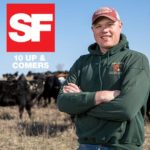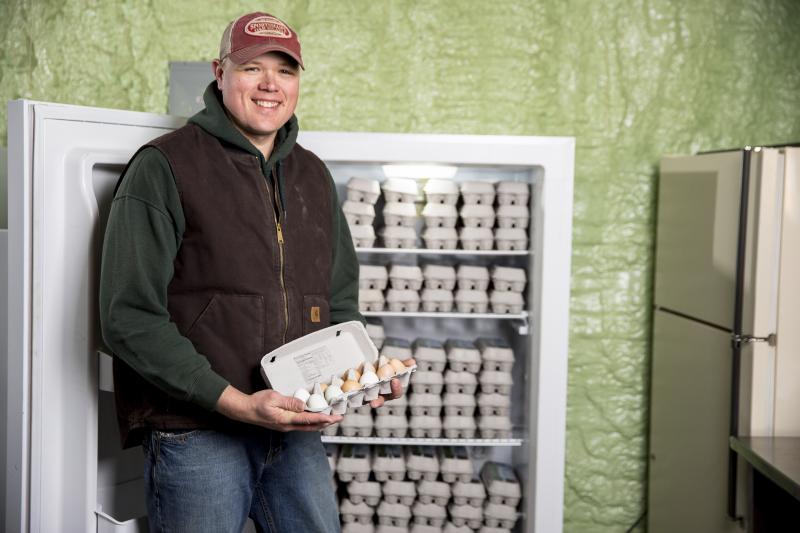Agriculture.com: Adding Animals Adds Profit, Organic Matter for North Dakota Farm
By Laurie Bedord
5/31/2017
The quality of food Paul Brown raises hinges on the quality of the soil on which it is grown.

“When my parents purchased the farm from my grandfather in 1991, the soil’s organic matter ranged from 1.7% to 1.9%,” he says. “Four years of crop failure and nearly going broke got my dad thinking outside the box. He began growing multispecies crops, expanding crop rotation, and eventually growing cover crops to diversify and build the soil’s resiliency.”
From a very young age, cattle were part of life on the farm for Brown. “We always had about 250 pairs grazing the land, and we marketed directly to consumers,” he says.
It wasn’t until he returned to the farm in 2010, after graduating from North Dakota State University, that the idea for diversifying this part of the business also took shape.
“These soils developed over thousands of years with grazing animals rotating throughout the landscape,” says the 29-year-old. “The longer we can keep land and livestock integrated, the healthier our soils will be. If we can mimic the template nature laid out for us, we will continue to build the resilience back into the ecosystem that was damaged.”
Hens and more
His first year back, Brown invested in 100 laying hens, which follow cattle on pasture. A mobile chicken coop serves as a place for the birds to lay eggs, roost, and take refuge at night.
“I started with hens because they are relatively low cost,” he says. “Since I had never raised hens before, I wouldn’t have gone broke if it was a complete debacle.”
Grazing is supplemented with grain by-products. “We do some grain cleaning and sell cover crop seed. Those screenings are fed to the hens. We are turning a waste product into eggs we can sell. Once you start to build enterprises that are feeding off each other, that is where a lot of profitability comes in,” Brown says.
Looking to find a market for his eggs, he connected with a local CSA (community supported agriculture) group.
“I was exposed to 125 potential customers,” he says. “Most of them ended up buying from me and still do. It was a great product to introduce to customers because they are willing to pay $5 for a dozen eggs.”
Today, his flock has grown to over 1,000 laying hens. Once customers realized how good the eggs were, demand grew for other offerings.
“In 2013, I added hair sheep. I started with 20 ewe lambs and a ram,” he says. “I am up to 150 ewes now. A year later, I added six sows and a boar and have 25 Berkshire and Tamworth sows farrowing out today. Pigs are raised on pasture and fed non-GMO grains grown on the ranch.”
Integrating a variety of animals has flourished into a successful business. It has also paid dividends in bolstering organic matter, which is close to 7% today.
“Knowing what I know now, I think I can reach 12% by the time I retire,” Brown says.

Paul Brown began raising 100 laying hens to further diversify his family’s farming operation. Today, his flock has grown to more than 1,000.
Expanding Markets
As his business has grown, so has the way he markets his products. In 2013, Brown’s Marketing LLC was born to separate it from the ranch. Along with the CSA, Brown sells his products at farmers markets in Bismarck and Fargo. This year he plans to add Minot once a month.
Customers can also purchase products through the company’s website nourishedbynature.us. To make delivery a seamless process, he integrated the farmers markets with the online store. “You can pick up your online order at one of the farmers markets we attend. That way we ensure we have what you want,” he says.
If that option doesn’t work for you, he has eight other pick-up locations throughout North Dakota. Deliveries are made once a month.
“As far as local foods go, North Dakota is behind other states,” says Brown. “We are blazing the trail. Hopefully, we are opening up opportunities for others to do what we are doing.”
Growing The Connection
Over the past four years, linking the land to livestock isn’t the only relationship Brown has worked to build.
“When I started selling eggs, I realized there was really a desire for my customers to know their farmer, where their food comes from, and how it is produced,” he says. “Transparency and trust are huge for the consumer.”
He keeps customers engaged through social media as well as a monthly newsletter he writes personally. In addition, he and his father, Gabe, share their experiences by speaking at conferences, workshops, and field days.
An idea that started with 125 potential customers has grown to nearly 10 times that today. “We have 1,000 registered customers on the website, and that doesn’t include the customers we reach through the farmers markets,” he says.
Yet, there is still work to be done.
“We are only 10 miles from 110,000 people. We get new neighbors around us every day who could be future customers and friends,” Brown says. “We have to look at it like that. Otherwise, we won’t be able to last.”
Advancing Soil Health
Brown has had a good teacher in his father, Gabe, who developed a healthy soil ecosystem by following the five principles below.
- Don’t till. Brown went 100% no-till in 1994 and has not tilled since.
- Protect the soil surface. Brown deplores bare soil. “Keep it covered to prevent wind and water erosion and to prevent evaporation,” he says.
- Diversify. A wide array of crops is planted. “We try to have both cash and cover crops growing on every field, every year,” Brown says.
- Keep a living root. “Never have a field without a growing plant on it for as long as possible throughout the year,” he says.
- Create an integrated system. The Browns integrate their livestock on cropland to graze the cover crops. “Cover crops also provide a home for predator insects and pollinators,” he explains.
“We must focus on regenerating our resources,” adds Brown. “We have a human health crisis in this country. Partially to blame is the fact that we have degraded our soil ecosystem. If we don’t have a healthy, functioning soil ecosystem, we cannot have nutrient-dense foods. We also have to focus on the soil to heal the carbon and water cycles.”